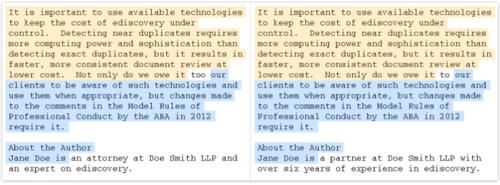Wednesday’s ILTA Sessions – eDiscovery Trends

Usually I write these blog posts early and schedule them to post in the middle of the night. However, this is Vegas and it is the middle of the night, so I don’t have to schedule the post. Viva Las Vegas! 🙂
As noted Monday and yesterday, the International Legal Technology Association (ILTA) annual educational conference of 2013 is happening this week and eDiscoveryDaily is here to report about the latest eDiscovery trends being discussed at the show. There’s still time to check out the show if you’re in the Las Vegas area with a number of sessions available and over 180(!) exhibitors providing information on their products and services. Here are today’s sessions in the main conference tracks related to litigation support and eDiscovery.
11:00 AM – 12:30 PM:
Hot Topics in E-Discovery
Description: In this open forum discussion, you’ll get to participate in a topic-based dialogue with peers and colleagues on the hottest issues and trends in e-discovery. ILTA members can vote on and influence the list of topics in the weeks leading up to the conference. While loosely moderated, audience participation and questions are encouraged and will drive this session!
Speakers are: David Cowen – The Cowen Group; Steven L. Clark – Lathrop & Gage LLP.
1:30 PM – 2:30 PM:
Technology and Better Project Management
Description: Keeping up with the ever-changing technology around collecting, processing and reviewing data poses a huge challenge to many case teams. The technology is clearly part of the process, but the question remains: Is the process driven by the technology or by principles of project management? Those working to form a litigation support department or those struggling to set up a project plan will get answers here, as we focus on the process of using technology in different ways to develop a straightforward project plan that the case team can use and rely on from case to case.
Speakers are: Cindy MacBean – Watt, Tieder, Hoffar & Fitzgerald; Gordon Moffat – Baker Donelson Bearman Caldwell & Berkowitz; Duane Lites – Jackson Walker L.L.P.; Chad Papenfuss – Kirkland & Ellis LLP.
3:30 PM – 4:30 PM:
A Numbers Game: The Value of E-Discovery Metrics
Description: Einstein once said, “Not everything that counts can be counted, and not everything that can be counted counts.” Come find out which e-discovery metrics really count. Corporate counsel want more certainty surrounding the time and cost of e-discovery, and our panelists will share their experiences implementing e-discovery metrics and lessons learned. Join us as we explore what to measure, how to collect data and what key metrics have added value for clients.
Speakers are: Florinda Baldridge – Norton Rose Fulbright; Browning E. Marean – DLA Piper; Beth Patterson – Allens; William W. Belt – Deloitte.
For a complete listing of all sessions at the conference, click here.
So, what do you think? Are you planning to attend ILTA this year? You’re running out of time! Please share any comments you might have or if you’d like to know more about a particular topic.
Disclaimer: The views represented herein are exclusively the views of the author, and do not necessarily represent the views held by CloudNine Discovery. eDiscoveryDaily is made available by CloudNine Discovery solely for educational purposes to provide general information about general eDiscovery principles and not to provide specific legal advice applicable to any particular circumstance. eDiscoveryDaily should not be used as a substitute for competent legal advice from a lawyer you have retained and who has agreed to represent you.






